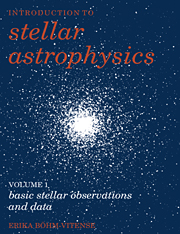Book contents
- Frontmatter
- Contents
- Preface
- 1 Positions of stars
- 2 Proper motions of stars
- 3 Distances of nearby stars
- 4 The brightnesses of the stars
- 5 Color magnitude diagrams
- 6 The luminosities of the stars
- 7 Angular radii of stars
- 8 Effective temperatures of stars
- 9 Masses and radii of stars
- 10 Spectral classification
- 11 Understanding stellar spectra
- 12 Population II stars
- 13 Stellar rotation
- 14 Stellar magnetic fields
- 15 Stars with peculiar spectra
- 16 Pulsating stars
- 17 Explosive stars
- 18 Our sun
- 19 Interstellar absorption
- Appendixes
- References
- Index
10 - Spectral classification
Published online by Cambridge University Press: 04 August 2010
- Frontmatter
- Contents
- Preface
- 1 Positions of stars
- 2 Proper motions of stars
- 3 Distances of nearby stars
- 4 The brightnesses of the stars
- 5 Color magnitude diagrams
- 6 The luminosities of the stars
- 7 Angular radii of stars
- 8 Effective temperatures of stars
- 9 Masses and radii of stars
- 10 Spectral classification
- 11 Understanding stellar spectra
- 12 Population II stars
- 13 Stellar rotation
- 14 Stellar magnetic fields
- 15 Stars with peculiar spectra
- 16 Pulsating stars
- 17 Explosive stars
- 18 Our sun
- 19 Interstellar absorption
- Appendixes
- References
- Index
Summary
The spectral sequence
So far we have talked only about global properties of the stars and about their brightnesses in broad wavelength bands. We get, of course, more information when we reduce the widths of the wavelength bands in which we study the radiative energy emitted by the stars. If we reduce the bandwidth to the order of a few Å or even a fraction of an Å, and cover all wavelengths, we talk of stellar spectra. If we compare spectra of different stars, we see that there are many different kinds of spectra. Most of them can be ordered in a continuous sequence of spectra, the so-called spectral sequence. In Fig. 10.1 we show the sequence as it is used now, and as it was established finally by Morgan, Keenan and Kellman (1943).
If we plot the energy distribution in a spectrum as a function of wavelength, we get plots as shown in Figs 10.2. Basically, we see a continuous energy distribution (Fig. 10.2(a)), but there are many wavelengths for which the energy is reduced by varying amounts, the so-called spectral lines, see Fig. 10.2(b). If we look at these wavelengths in a spectrum, they look dark because there is little energy at these wavelengths. Such dark lines are called absorption lines. There are also some spectra which have bright lines, i.e., for which there is more energy at these wavelengths.
- Type
- Chapter
- Information
- Introduction to Stellar Astrophysics , pp. 89 - 98Publisher: Cambridge University PressPrint publication year: 1989
- 4
- Cited by

